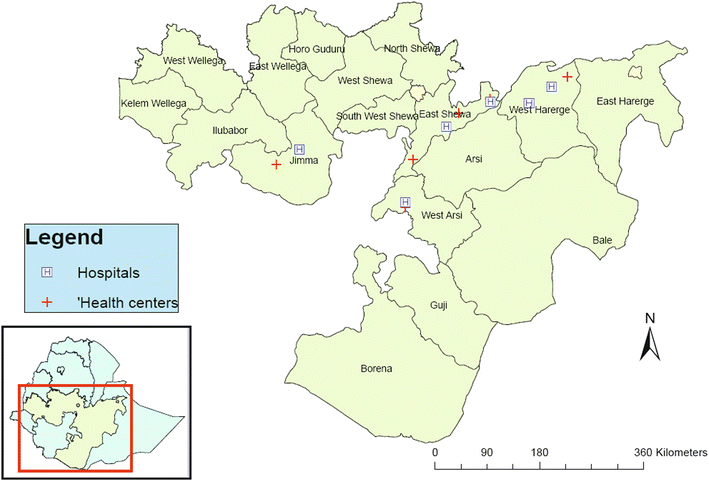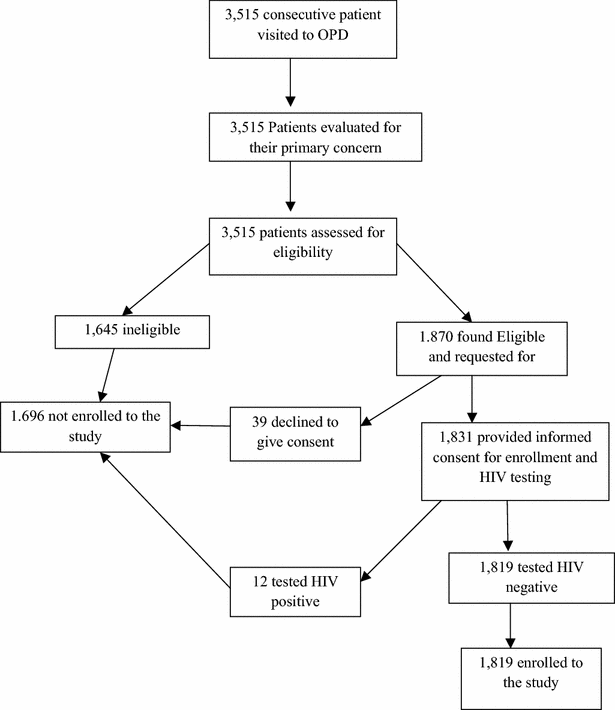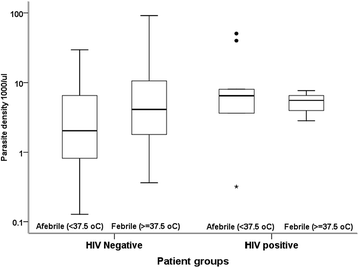Burden of malaria among adult patients attending general medical outpatient department and HIV care and treatment clinics in Oromia, Ethiopia: a comparative cross-sectional study
- PMID: 26671012
- PMCID: PMC4681039
- DOI: 10.1186/s12936-015-1029-0
Burden of malaria among adult patients attending general medical outpatient department and HIV care and treatment clinics in Oromia, Ethiopia: a comparative cross-sectional study
Abstract
Background: Malaria and HIV/AIDS constitute major public health problems in Ethiopia, but the burden associated with malaria-HIV co-infection has not been well documented. In this study, the burden of malaria among HIV positive and HIV negative adult outpatients attending health facilities in Oromia National Regional State, Ethiopia was investigated.
Methods: A comparative cross-sectional study among HIV-positive patients having routine follow-up visits at HIV care and treatment clinics and HIV-seronegative patients attending the general medical outpatient departments in 12 health facilities during the peak malaria transmission season was conducted from September to November, 2011. A total of 3638 patients (1819 from each group) were enrolled in the study. Provider initiated testing and counseling of HIV was performed for 1831 medical outpatients out of whom 1819 were negative and enrolled into the study. Malaria blood microscopy and hemoglobin testing were performed for all 3638 patients. Data was analyzed using descriptive statistics, Chi square test and multivariate logistic regression.
Results: Of the 3638 patients enrolled in the study, malaria parasitaemia was detected in 156 (4.3%); malaria parasitaemia prevalence was 0.7% (13/1819) among HIV-seropositive patients and 7.9% (143/1819) among HIV-seronegative patients. Among HIV-seropositive individuals 65.4% slept under a mosquito bed net the night before data collection, compared to 59.4% of HIV-seronegative individuals. A significantly higher proportion of HIV-seropositive malaria-negative patients were on co-trimoxazole (CTX) prophylaxis as compared to HIV-malaria co-infected patients: 82% (1481/1806) versus 46% (6/13) (P = 0.001). HIV and malaria co-infected patients were less likely to have the classical symptoms of malaria (fever, chills and headache) compared to the HIV-seronegative and malaria positive counterparts. Multivariate logistic regression showed that HIV-seropositive patients who come for routine follow up were less likely to be infected by malaria (OR = 0.23, 95% CI = 0.09-0.74).
Conclusion: The study documented lower malaria prevalence among the HIV-seropositive attendants who come for routine follow up. Clinical symptoms of malaria were more pronounced among HIV-seronegative than HIV-seropositive patients. This study also re-affirmed the importance of co-trimoxazole in preventing malaria symptoms and parasitaemia among HIV-positive patients.
Figures




Similar articles
-
Prevalence of malaria and anaemia among HIV infected pregnant women receiving co-trimoxazole prophylaxis in Tanzania: a cross sectional study in Kinondoni Municipality.BMC Pharmacol Toxicol. 2014 Apr 24;15:24. doi: 10.1186/2050-6511-15-24. BMC Pharmacol Toxicol. 2014. PMID: 24761799 Free PMC article.
-
Effect of HIV and malaria parasites co-infection on immune-hematological profiles among patients attending anti-retroviral treatment (ART) clinic in Infectious Disease Hospital Kano, Nigeria.PLoS One. 2017 Mar 27;12(3):e0174233. doi: 10.1371/journal.pone.0174233. eCollection 2017. PLoS One. 2017. PMID: 28346490 Free PMC article.
-
Outcomes of TB treatment in HIV co-infected TB patients in Ethiopia: a cross-sectional analytic study.BMC Infect Dis. 2016 Nov 4;16(1):640. doi: 10.1186/s12879-016-1967-3. BMC Infect Dis. 2016. PMID: 27814693 Free PMC article.
-
Scaling-up co-trimoxazole prophylaxis in HIV-exposed and HIV-infected children in high HIV-prevalence countries.Lancet Infect Dis. 2007 Oct;7(10):686-93. doi: 10.1016/S1473-3099(07)70239-6. Lancet Infect Dis. 2007. PMID: 17897611 Review.
-
The expanding role of co-trimoxazole in developing countries.Lancet Infect Dis. 2015 Mar;15(3):327-39. doi: 10.1016/S1473-3099(14)71011-4. Epub 2015 Jan 21. Lancet Infect Dis. 2015. PMID: 25618179 Review.
Cited by
-
Effect of malaria and HIV/AIDS co-infection on red blood cell indices and its relation with the CD4 level of patients on HAART in Bench Sheko Zone, Southwest Ethiopia.PLoS One. 2022 Mar 4;17(3):e0263865. doi: 10.1371/journal.pone.0263865. eCollection 2022. PLoS One. 2022. PMID: 35245289 Free PMC article.
-
A Systematic Review and Meta-Analysis of Malaria Test Positivity Outcomes and Programme Interventions in Low Transmission Settings in Southern Africa, 2000-2021.Int J Environ Res Public Health. 2022 Jun 1;19(11):6776. doi: 10.3390/ijerph19116776. Int J Environ Res Public Health. 2022. PMID: 35682356 Free PMC article.
-
Determinants of HIV-malaria co-infection among people living with HIV on anti-retroviral therapy in Northeast Ethiopia: unmatched case control study.Trop Med Health. 2020 Nov 30;48(1):94. doi: 10.1186/s41182-020-00286-9. Trop Med Health. 2020. PMID: 33292761 Free PMC article.
-
Prevalence of malaria and its risk factors in Lake Tana and surrounding areas, northwest Ethiopia.Malar J. 2022 Nov 4;21(1):313. doi: 10.1186/s12936-022-04310-7. Malar J. 2022. PMID: 36333723 Free PMC article.
-
Malaria parasite prevalence and Haematological parameters in HIV seropositive patients attending the regional hospital Limbe, Cameroon: a hospital-based cross-sectional study.BMC Infect Dis. 2019 Nov 21;19(1):988. doi: 10.1186/s12879-019-4629-4. BMC Infect Dis. 2019. PMID: 31752719 Free PMC article.
References
-
- WHO . Malaria and HIV interactions and their implications for public health policy. Geneva: World Health Organization; 2005.
-
- Federal Ministry of Health. Health and health related indicators. Ethiopia: Addis Ababa; 2012.
-
- Central Statistical Agency and ICF International . Ethiopia demographic and health survey 2011. Ethiopia and Calverton, Maryland, USA: Addis Ababa; 2012.
-
- Addissie A, Sellassie FE, Deressa W. Malaria and HIV co-infection in Hadya Zone, southern Ethiopia. Ethiop Med J. 2007;45:9–17. - PubMed
Publication types
MeSH terms
Substances
Grants and funding
LinkOut - more resources
Full Text Sources
Other Literature Sources
Medical

